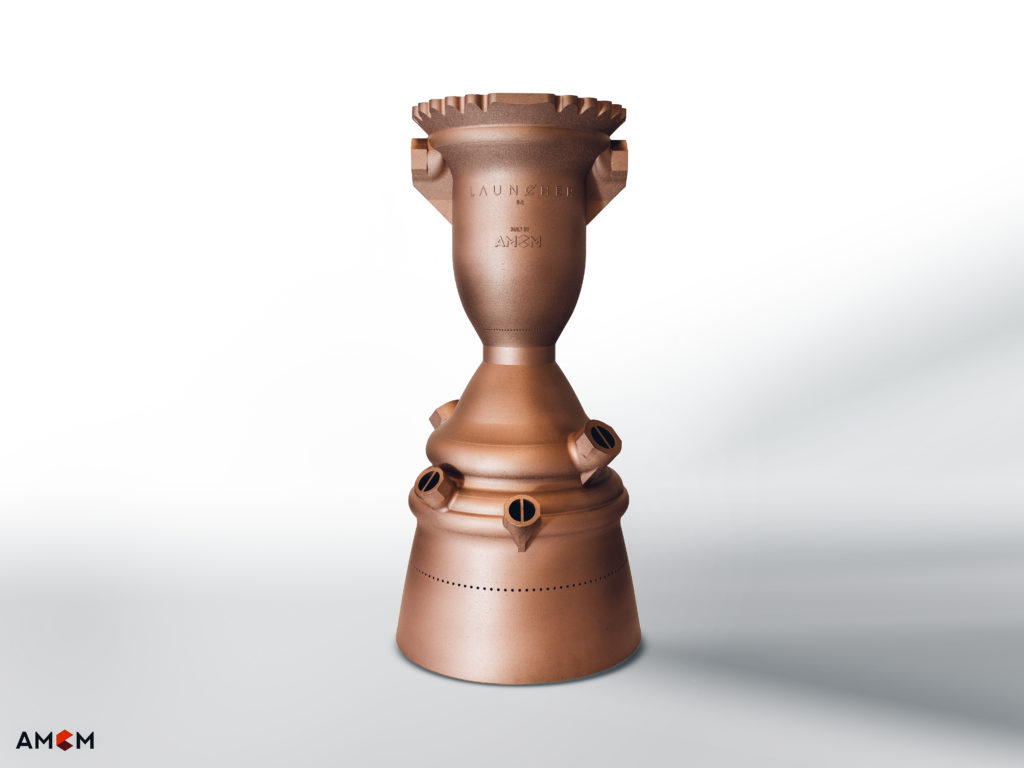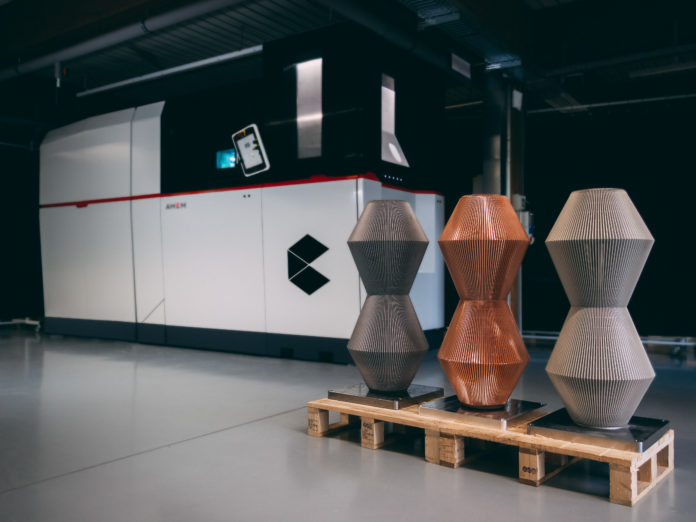Most of the time, customization is highlighted as one of the major benefits of 3D printing when it comes to 3D printed objects themselves. In such cases, the 3D printing process does not really change. In fact, the process simply consists in the choice of some random items by the customer to get the expected product. However, the focus on the manufacturing process shows that customization can be much more complex than it looks like. A conversation with AMCM GmbH’s Martin Bullemer and Felix Bauer explains why.

Felix Bauer 
AMCM GmbH Geschäftsführer Martin Bullemer / Starnberg (Bayern) Foto: Tobias Hase / AMCM
Creating a business model that works.
Both men met at EOS GmbH. With roots in industrial processing, Bullemer has more than 15 years of experience at EOS where he supported the development of the additive manufacturing market in the US and in the medical industry. Bauer on the other hand, is an industrial engineer who joined EOS GmbH six years ago with the ambition to support the growth of AM within the aerospace industry.
At the time, EOS received many requests that almost outlined the same challenge: the need for companies to become more mature while following the path to industrialization. The thing is that companies with more specific requests often tended to be left apart.
“Such requests include for instance, but are not limited to the need for different kinds of shapes, different kinds of building envelopes, the need to process copper – a very complex material -, heating from the top and the bottom, and even the need for more powerful lasers”, Bauer states.
Rather than just being an expert at developing a new geographical segment for EOS or a specific vertical industry adopting AM, Bullemer saw an opportunity to bring additional expertise on the table, an opportunity to tap into new markets, to create new revenue streams and expand product offerings.
Although the idea was brilliant, it also raised several questions and uncertainties. “Those requests that were often left apart mostly require further customization. Although we wanted to address their challenges, we did not know how big the market was. Furthermore, when you are a big company, you cannot develop a new company with the same flexibility than with a start-up; you cannot start a new technology development just to market ten systems, you cannot start the development of a machine when you are not sure somebody will pay for it”, Bullemer emphasizes.
All those “what-ifs” made sense. Although, we should recognize leading companies’ go-to-market capabilities, it was simply too risky to afford to meet each unique demand with a new 3D printer. That’s why 2017 saw the creation of AMCM GmbH which stands for Additive Manufacturing Customized Machines. As the name implies, the company is born with the goal to provide industries with customized LPBF (Laser Beam Powder Bed Fusion) machines from EOS.
At the time we write these lines, Bullemer is Managing Director at AMCM GmbH and Bauer is currently Regional Director EMEA | DACH/NL at EOS and in transition phase to join AMCM GmbH full-time.

Innovation and entrepreneurship can come in many shapes and sizes.
Unlike industrial 3D printers from its fellow machine manufacturers, we cannot legitimately describe all the features developed in an industrial 3D printer from AMCM GmbH – and with good reason: “we focus on applications. A customer comes to us with a specific request and we work on a solution that might fit a specific need. Obviously, over time, we came to realize that some needs might be easier to fulfil than others. For instance, we received a lot of requests for machines with customized build sizes. These are relatively easy use cases because they require mechanical engineering tuning, not to mention the fact that you do not have to change the entire process”, the Managing Director explains.
“Every machine manufacturer has his standard portfolio, which might fit or not to the application of the customer – at least to a certain degree. At AMCM, we take a very close look at that application and make the machine fits into that. Of course, sometimes, the standard solution is good enough for the customer, but for those who need that ‘extra thing’ that will make a difference in their projects, for them, AMCM comes into play”, the regional director completes.
As we discussed the requests they often received from their customers, we came to realize that the question is not about the number or the type of requests they are able to manage, but above all, what makes them outstanding. Trivial but crucial.
From system requirements, part design to material development and beyond, additive manufacturing systems require a lot to process, but some functionalities are just more pivotal than others. It is for instance, the case of laser and optical features that require extensive knowledge in the development of a machine. At AMCM, half of the team is coming from the laser industry. “We definitely have an expertise in laser tuning – different wavelength, different laser types – and in the selection of the right optical set-up, which is a key component in every additive manufacturing machine”, Bullemer notes.
Furthermore, although an inquiry from AMCM might lead to the development of a dedicated depowdering solution as we saw with the Solukon’s SFM-AT1000 machine, it should be noted that each industry 3D printer does not necessarily require a dedicated post-processing equipment. As a matter of fact, at the end of the day, it’s up to the customer to decide what depowdering or powder handling solution he will go for.
Thereafter, comes the question of price. Countless examples in the automotive industry show that luxury vehicles provide increased levels of comfort, equipment, amenities, quality, performance, and status relative to regular cars for an increased price. Although “luxury” might be a quite subjective term, the fact remains that car manufacturers that develop vehicles with an unusual level of performance have created a separate brand for them and commercialize these vehicles at a price that is not always seen on the standard market.
In a certain sense, this very-much understandable theory can be applied to the manufacturing industry. As per the words of Bullemer, “customers-dedicated machines are not often commercialized the same way that conventional AM machines, therefore, unlike their fellow machine manufacturers, manufacturers of customers-dedicated machines do not often have the benefits of a very well-established supply chain. Indeed, the less you build, the more costs you have. Furthermore, every modification requires an engineering effort that needs to be balanced. In the same vein, a customer can come with a unique crazy idea in mind. Once we have developed a solution for this idea, the chances are very high that we will no longer sell the same machine to another customer. In principle, these machines are always a little bit more expensive than the others but we make things possible and our customers only buy if their business case is working.”
Efficiency, measure of throughput?
“…only buy if [your] business case [works].” Bullemer’s statement emphasizes that price is just one element of the story. Most importantly, it outlines “efficiency” as measure of throughput and refocuses the debate on applications.
The ongoing race for space for instance has seen a boom in satellite applications. Although this industry is a very conservative one, the past years saw applications that are due to the combination of a wide range of technologies, not just additive manufacturing. According to Bauer, “young engineers do no longer rely on what has been done before, they have a much wider range of choices when it comes to production and there is a certain demand on the market for such needs. Plus, a close look at the market shows that the private space is the one that actually drives the industry.”
In the private space business, commercial motivations require to focus on the highest performance at the lowest cost. And one way to bring this utopian winning formula closer to its reality is to bring metal AM in the game.
“Rockets are the perfect example of such cases as they require unparalleled efficiency for commercial space deliveries”, Bauer stresses. If you are an aerospace engineer, it is certainly no secret to you that propellant is often the heaviest part of a launch vehicle’s mass (up to 90% of a launch vechicle’s mass). Therefore, reducing propellant use leads to further opportunities to reduce vehicle mass, therefore to increase payload and performance for the same rocket size. But these are just one element of the manufacturing process. The point is, those “rocket parts are very complex to manufacture. [While lightness and robustness are two pivotal factors that can be improved through AM,] it should be noted that these parts always need to be achieved within very short-lead times. Most importantly, they require a machine that can easily enable iteration, reinvention, reproducibility and a smooth process to the next stage of manufacturing. At the end of the day, that’s the most important”, Bauer continues.
One example that illustrates this argument is the recent achievement of New-York-based startup Launcher. During the last quarter of 2020, the space company started testing its full-sized E-2 liquid rocket engine, a technological progress that paves the way to more affordable and high-performance solutions for smaller space launch vehicles.
“Launcher has influenced the design of our machines. The challenge was to demonstrate that we could print a one metre tall single-piece copper alloy combustion chamber, an area where companies do not have much expertise in. It’s a huge challenge because there is a high-risk of failure when you try it the first time. Such production requires a good know-how about AM and the Space startup had just started to design for AM and they were really depending on the right know-how to make their ideas come to life. The next step is to get funding to accelerate development of this E-2 engine”, the Managing Director, points out.
We learned that such parts are typically 450 x 450 x 1000 mm in dimensions, they are made out of CuCr1Zr and feature intricate internal regenerative cooling channels, hence the need for a dedicated system capable to process this type of material. To make it happen, the company finally used its AMCM M4K 3D printer and tested the parts at NASA Stennis Space Center.
“That’s the beauty of being a startup”, Bullemer adds. Not to mention that “you have a bunch of people who share the same vision and the same willingness to achieve it”, completes Bauer.
“We make it happen”
“We make it happen.” How many times have you heard these four words before realizing that a lot is promised and little is actually delivered. Today, while looking at AMCM’s business model, the precautions the team took before its implementation and above all the applications they are achieving, I am ready to take their words for it.
Disclaimer: This interview has initially been published in the January/February issue of 3D ADEPT Mag . Felix Bauer now serves as Head of Marketing & Sales at AMCM GmbH.
Remember, you can post free of charge job opportunities in the AM Industry on 3D ADEPT Media or look for a job via our job board. Make sure to follow us on our social networks and subscribe to our weekly newsletter : Facebook, Twitter, LinkedIn & Instagram ! If you want to be featured in the next issue of our digital magazine or if you hear a story that needs to be heard, make sure to send it to contact@3dadept.com




